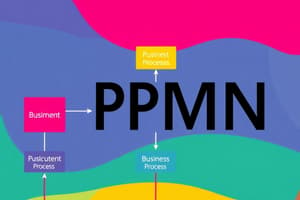Podcast
Questions and Answers
What do events in a business process primarily represent?
What do events in a business process primarily represent?
- Resources required for the process
- Actions taken by participants in the process
- Something that happens during the process (correct)
- Decisions made during the process
How can events affect the flow of a business process?
How can events affect the flow of a business process?
- By initiating new resources
- By serving as milestones
- By starting, interrupting, or ending the process flow (correct)
- By providing feedback to participants
Which of the following best describes a trigger in the context of business process events?
Which of the following best describes a trigger in the context of business process events?
- An action performed by a resource
- An external condition that initiates an event (correct)
- A decision point in the process
- The result of a completed process
Which of the following is NOT a function of events in a business process?
Which of the following is NOT a function of events in a business process?
What is the primary purpose of BPMN icons in process modeling?
What is the primary purpose of BPMN icons in process modeling?
Which task might involve writing natural language descriptions based on process models?
Which task might involve writing natural language descriptions based on process models?
Which of the following could be considered a result of an event in a business process?
Which of the following could be considered a result of an event in a business process?
What is a common mistake when modelling multiple pools?
What is a common mistake when modelling multiple pools?
Which action would be considered a severe best practice violation?
Which action would be considered a severe best practice violation?
Which of the following is a moderate best practice violation?
Which of the following is a moderate best practice violation?
What characterizes a lane in process modelling?
What characterizes a lane in process modelling?
Which problem is related to improper task assignment in process modelling?
Which problem is related to improper task assignment in process modelling?
What happens when a software application terminates in a multi-instance activity?
What happens when a software application terminates in a multi-instance activity?
How is the number of instances in a multi-instance activity determined?
How is the number of instances in a multi-instance activity determined?
What does the double border in a process model indicate?
What does the double border in a process model indicate?
Which type of loop allows for a known number of iterations at design time?
Which type of loop allows for a known number of iterations at design time?
What is indicated by the ad hoc marker in process modeling?
What is indicated by the ad hoc marker in process modeling?
Which of the following is NOT a characteristic of a multi-instance activity?
Which of the following is NOT a characteristic of a multi-instance activity?
In the context of business process execution, a task that provides input to a Business Rules Engine is considered what?
In the context of business process execution, a task that provides input to a Business Rules Engine is considered what?
What defines a task that uses a web service in process execution?
What defines a task that uses a web service in process execution?
Which loop type operates in parallel according to design type?
Which loop type operates in parallel according to design type?
What happens when new data is provided during the writing process?
What happens when new data is provided during the writing process?
What do Intermediate Events attached to the boundary of an activity represent?
What do Intermediate Events attached to the boundary of an activity represent?
What can be a trigger for the Event in process modeling?
What can be a trigger for the Event in process modeling?
In which situation does the process flow continue to task 3?
In which situation does the process flow continue to task 3?
What is mainly indicated by a start event in process modeling?
What is mainly indicated by a start event in process modeling?
What characteristic distinguishes a Transaction activity in process modeling?
What characteristic distinguishes a Transaction activity in process modeling?
What is one purpose of compensation handling in processes?
What is one purpose of compensation handling in processes?
How do exceptions interact with the flow of process activities?
How do exceptions interact with the flow of process activities?
Which of the following statements is true about event handling?
Which of the following statements is true about event handling?
Which option best describes the role of a Timer in process modeling?
Which option best describes the role of a Timer in process modeling?
What describes a non-interrupting border event in process modeling?
What describes a non-interrupting border event in process modeling?
Which message type leads to the execution of a task while interrupting another?
Which message type leads to the execution of a task while interrupting another?
What occurs when receiving a meeting request in the context of process modeling?
What occurs when receiving a meeting request in the context of process modeling?
How does a data flow function within process modeling?
How does a data flow function within process modeling?
What is the role of Messages 2, 3, and 4 in the context of task execution?
What is the role of Messages 2, 3, and 4 in the context of task execution?
What defines an implicit message flow in process modeling?
What defines an implicit message flow in process modeling?
Which describes an intermediate throwing event?
Which describes an intermediate throwing event?
What distinguishes an interrupting border event from a non-interrupting one?
What distinguishes an interrupting border event from a non-interrupting one?
What is the likely result of an incoming interrupting event?
What is the likely result of an incoming interrupting event?
Which statement about task execution in process modeling is true?
Which statement about task execution in process modeling is true?
Flashcards
BPMN Icons
BPMN Icons
Graphical representations used to construct Business Process Model and Notation (BPMN) diagrams.
BPMN Events
BPMN Events
Represent occurrences that influence the flow of a business process.
BPMN Flow
BPMN Flow
Represent the flow of work or information within a business process.
BPMN Activities
BPMN Activities
Signup and view all the flashcards
BPMN Gateways
BPMN Gateways
Signup and view all the flashcards
BPMN Pools and Lanes
BPMN Pools and Lanes
Signup and view all the flashcards
BPMN Data Objects
BPMN Data Objects
Signup and view all the flashcards
Process Execution
Process Execution
Signup and view all the flashcards
Send Task
Send Task
Signup and view all the flashcards
Receive Task
Receive Task
Signup and view all the flashcards
Multi-instance Activity
Multi-instance Activity
Signup and view all the flashcards
Standard Loop
Standard Loop
Signup and view all the flashcards
Sequential Loop
Sequential Loop
Signup and view all the flashcards
Parallel Loop
Parallel Loop
Signup and view all the flashcards
Sub-process with Transactional Properties
Sub-process with Transactional Properties
Signup and view all the flashcards
Ad-hoc Marker
Ad-hoc Marker
Signup and view all the flashcards
Throwing Event
Throwing Event
Signup and view all the flashcards
Data Flow
Data Flow
Signup and view all the flashcards
Non-Interrupting Border Event
Non-Interrupting Border Event
Signup and view all the flashcards
Interrupting Border Event
Interrupting Border Event
Signup and view all the flashcards
Intermediate Throwing Event
Intermediate Throwing Event
Signup and view all the flashcards
Catching Event
Catching Event
Signup and view all the flashcards
Message Flow
Message Flow
Signup and view all the flashcards
Border Event
Border Event
Signup and view all the flashcards
Process Modelling
Process Modelling
Signup and view all the flashcards
Process Deployment
Process Deployment
Signup and view all the flashcards
Incorrect Pool Modelling
Incorrect Pool Modelling
Signup and view all the flashcards
Treating Lanes as Pools
Treating Lanes as Pools
Signup and view all the flashcards
BPMN Deadlock
BPMN Deadlock
Signup and view all the flashcards
Multiple Start Events
Multiple Start Events
Signup and view all the flashcards
Incorrect End Event
Incorrect End Event
Signup and view all the flashcards
Intermediate Event
Intermediate Event
Signup and view all the flashcards
Timer Event
Timer Event
Signup and view all the flashcards
Exception Event
Exception Event
Signup and view all the flashcards
Message Event
Message Event
Signup and view all the flashcards
Transaction
Transaction
Signup and view all the flashcards
Compensation Handling
Compensation Handling
Signup and view all the flashcards
Start Event
Start Event
Signup and view all the flashcards
End Event
End Event
Signup and view all the flashcards
Study Notes
Master's in Computer Science and Business Management: Process Modelling and Deployment
- The course is offered by Instituto Universitário de Lisboa (iscte).
- The course covers process modelling and deployment.
- The professor for the course is José Cascais Brás.
BPMN Modelling Constructs
- The presentation covers BPMN (Business Process Model and Notation) modelling constructs.
- BPMN icons are used to model business processes.
- These icons convey specific meanings when used together.
- The diagrams using BPMN icons can be used to build phrases and are used to visually represent how different parts of a process are interrelated.
- The diagrams use icons for activities, events, gateways, and message flows.
- Examples of BPMN uses are shown in the slides, including the creation of a flowchart for an application process.
BPMN Icons (Modelling Constructs)
- BPMN icons represent various elements of business processes.
- The icons include tasks, gateways, events, and message flows.
- Different types of tasks (like manual, service, script, etc.) and events (like start, intermediate, end) are visually represented.
- Data objects and swimlanes are also included in the model constructs to visually demonstrate flow paths, and roles involved.
Best Practices and Common Mistakes
- The presentation discusses best practices in BPMN modelling.
- Common mistakes in BPMN modelling are also highlighted for avoiding them.
- Example violations of best practice are shown and explained.
- Naming conventions for start, activity/task, and end events are discussed, showing good and bad examples of naming in BPMN process diagrams.
- Best practice and common mistakes examples are presented.
Process Execution
- The presentation covers technology used in executing business processes.
- The execution of business processes is discussed with explanations of BPEL technology.
- BPEL (Business Process Execution Language) is a language used to specify the implementation details of business processes.
- BPEL is focused on the executable details of business processes
- BPEL does not contain graphical elements, in contrast with BPMN diagrams.
- Several tools, such as Apache ODE and Oracle BPM, support BPEL execution.
- The relationship between BPMN Modelling and BPEL process execution is clarified.
BPMN Model Serialization
- BPMN model serialization is used to interchange data between tools or processes.
- Serialization formats include XPDL and XMI.
- XPDL (XML Process Definition Language) is a standard used to represent BPMN diagrams, allowing other tools to exchange relevant details about a process.
- XMI (XML Metadata Interchange) is a standard used to exchange information about the elements of a model.
Signavio Import/Export Options
- Signavio offers import and export of various file types, allowing the interchange of data between different modelling tools.
- The tools import and export various types of processes.
XPDL (XML Process Definition Language)
- XPDL is an interchange format used to store BPMN diagram data.
- XPDL supports different BPMN versions, showing the capability to use for model interchange.
- XPDL is used by applications like Bizagi.
Standards Timeline - Releases
- The presentation displays a timeline of releases for BPMN and XPDL standards.
- The chart demonstrates the evolution of the standards.
XMI (XML Metadata Interchange)
- XMI is a standard used for exchanging BPMN model data.
- It includes the information about process graphics and semantics.
- The tool that is used is Enterprise Architect.
Process Execution Technology: BPEL
- BPEL (Business Process Execution Language) is an XML-based language
- It specifies the exact implementation details of a process (what to do and how to do).
- It is used in many process and workflow management tools.
- The focus of BPEL is solely on execution logic.
Mapping from BPMN to BPEL
- The presentation includes an example mapping from a BPMN diagram to a BPEL implementation.
- The example shows the mapping logic needed to implement a process in BPEL.
- The process is represented in a flowchart with different activities.
Common Modelling Mistakes
- Several common modelling mistakes are shown with explanations.
- Incorrect usage of Sequence Flows are shown.
- Improper Lanes in a BPMN Process is also described.
- Additional examples of common mistakes are illustrated.
Common Best Practices Violations
- Several examples of best practice violations are shown in BPMN process diagrams showing how the best practices can be applied to create better models.
- Avoiding implicit events or mixing different types of gateways are some examples.
Additional Examples
- The examples given in this section are for modelling different processes.
- Common processes like home pizza ordering, medical consultation and incident management are discussed to demonstrate how they can be modelled in BPMN.
Order to Delivery (Bottom-up Approach)
- A bottom-up approach is used for modelling the order to delivery process.
- This approach is beneficial in identifying tasks, their relationships and capturing the common meaning of the activities.
Order to Delivery (with Subprocesses)
- This presentation shows how to create a better process diagram by adding subprocesses to the diagrams.
- It explains how these steps are represented using subprocesses in a way that simplifies the diagram and improves its readability.
Order to Delivery (Top-down Approach)
- The diagram shows a top-down approach to creating the order to delivery process.
- The approach is beneficial because it shows the process from a high-level perspective to provide the overall details and flow path.
Studying That Suits You
Use AI to generate personalized quizzes and flashcards to suit your learning preferences.




